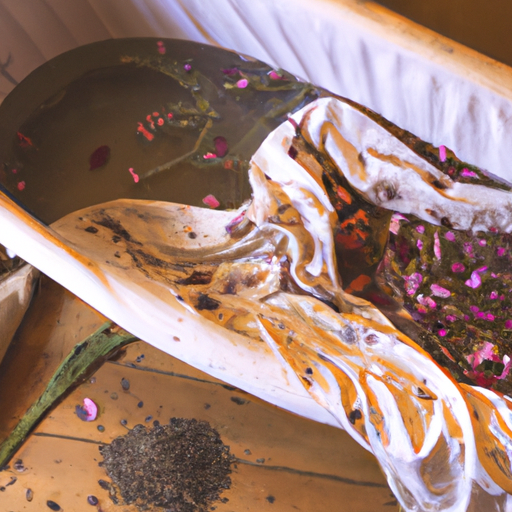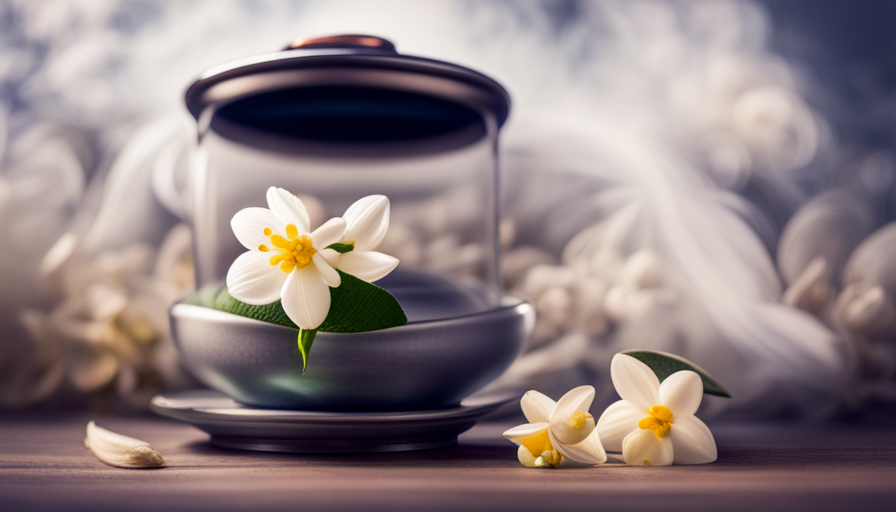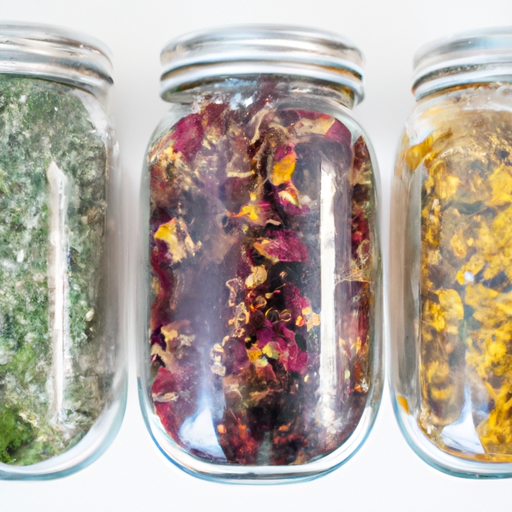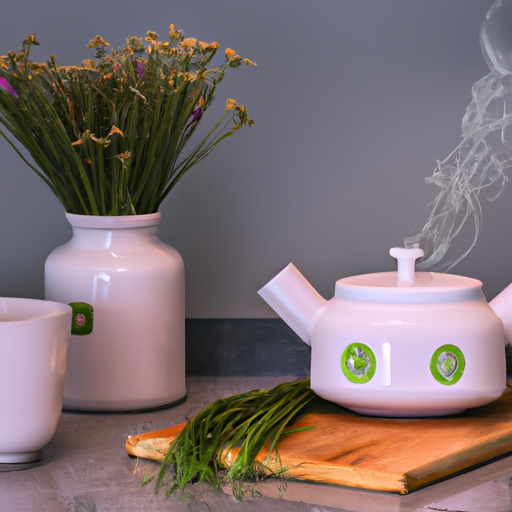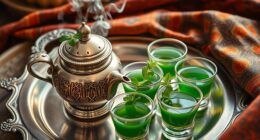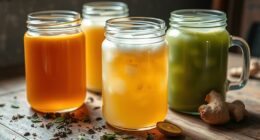Are you prepared to enjoy the ultimate relaxation experience?
Picture this: you’re sinking into a warm, soothing bath, surrounded by fragrant herbs that envelop you in a cloud of tranquility. Sounds incredible, right?
Well, I have a secret for you – it’s all possible with the magic of herbal bath tea.
In this article, I will guide you through the process of creating your own herbal bath tea, a luxurious self-care ritual that will nourish your mind, body, and soul. Trust me, once you try it, you’ll wonder how you ever lived without it.
By carefully selecting a blend of herbs and ingredients, you can create a personalized bath tea that caters to your specific needs – whether you’re seeking relaxation, rejuvenation, or stress relief.
With just a few simple steps, you’ll be on your way to transforming your bath time into an oasis of serenity.
So, get ready to immerse yourself in the healing power of nature.
Let’s dive in and discover the art of making an herbal bath tea.
Key Takeaways
- Herbal bath teas can be customized with specific herbs to cater to individual needs, such as relaxation, rejuvenation, and stress relief.
- Different herbs, like lavender, chamomile, jasmine, rosemary, and peppermint, offer various benefits, such as relaxation, energy boost, detoxification, and muscle relief.
- To make herbal bath tea, you will need muslin or cotton bags, dried herbs and flowers, Epsom salt or sea salt, and essential oils. The herbs should be finely ground and can be placed in bath bags or infusers.
- Creating a serene ambiance with soft lighting, calming scents, such as essential oils, soft music, and a peaceful atmosphere enhances the herbal bath experience.
Choose Your Herbs and Ingredients
Now, it’s time for you to pick out your favorite herbs and ingredients for your relaxing herbal bath tea. Herbal bath teas are not only a luxurious and soothing way to unwind, but they also offer numerous benefits for your mind and body. By infusing your bathwater with the healing properties of herbs, you can create a rejuvenating experience that promotes relaxation, relieves stress, and nourishes your skin.
When selecting herbs for your bath tea, consider the specific benefits you’re looking to achieve. Lavender, chamomile, and jasmine are popular choices for their calming properties, perfect for those seeking tranquility after a long day. If you’re in need of an energy boost, try incorporating rosemary or peppermint into your blend. For a detoxifying soak, consider herbs like rose petals, calendula, and green tea.
Experimenting with different herbal bath recipes can be a delightful adventure. You can mix and match herbs to create your unique blend that suits your preferences and needs. Don’t be afraid to get creative and explore different combinations until you find your perfect recipe.
Now that you have your herbs and ingredients selected, it’s time to gather your supplies for the next step of creating your herbal bath tea.
Gather Your Supplies
First, gather all the necessary items in order to create your very own soothing and aromatic blend for your relaxing soak. To make your herbal bath tea, you will need a few key supplies. Here is a list of what you will need:
| Supplies | Description |
|---|---|
| Muslin or cotton bags | These will be used to hold your herbal mixture while it steeps in the bathwater. |
| Dried herbs and flowers | Choose from a variety of options such as lavender, chamomile, rose petals, or mint. Each herb provides unique benefits for your bath. |
| Epsom salt or sea salt | Adding salt to your bath tea can help relax your muscles and detoxify your body. |
| Essential oils | If you want to enhance the scent of your bath tea, you can add a few drops of your favorite essential oil. |
Herbal bath teas have been used for centuries due to their numerous benefits. They can help relax your body and mind, soothe tired muscles, and promote overall well-being. There are different types of bath teas to choose from, depending on your specific needs. For example, lavender and chamomile are known for their calming properties, while mint can invigorate and refresh. Once you have gathered all your supplies, you can move on to preparing your herb mixture…
PREVIOUS SUBTOPIC: ‘Choose Your Herbs and Ingredients’
CURRENT SUBTOPIC: ‘Prepare Your Herb Mixture’
Prepare Your Herb Mixture
Once you’ve gathered all your supplies, it’s time to blend together a fragrant concoction that’ll transport you to a peaceful oasis of relaxation and rejuvenation. Herbal bath teas offer a multitude of benefits for both the mind and body. Different herb combinations can target specific needs, such as soothing sore muscles, promoting sleep, or even detoxifying the skin.
To prepare your herb mixture, start by selecting a base herb like chamomile or lavender, which are known for their calming properties. Next, add in herbs like rosemary or peppermint for a refreshing and invigorating experience. You can also include herbs such as calendula or comfrey, which are great for soothing irritated skin. Experimenting with different combinations will allow you to find the perfect blend that suits your individual needs and preferences.
To ensure the herbs release their beneficial properties into the bathwater, it’s important to finely grind them before use. This can be done using a mortar and pestle or a coffee grinder. Once the herbs are ground, mix them together thoroughly in a bowl.
In the subsequent section about ‘fill your bath bag or infuser’, we’ll explore how to prepare your bath bag or infuser to infuse the herbal goodness into your bathwater.
Fill Your Bath Bag or Infuser
To fully harness the therapeutic power of your chosen herbs, all you need to do is fill your bath bag or infuser with the finely ground mixture. This simple step will allow the herbs to release their beneficial properties into the bathwater, creating a soothing and rejuvenating experience.
When it comes to bath bags, there are various options available. One popular choice is a muslin bag, which is made from a breathable fabric that allows the herbs to infuse into the water while preventing any debris from escaping. Another option is a disposable tea bag, which is convenient and easy to use. Alternatively, you can also create your own bath bag using a small piece of cheesecloth or a stocking tied off with a string.
To help you understand the different types of bath bags available, here is a table outlining their features:
| Bath Bag Type | Features |
|---|---|
| Muslin Bag | Breathable fabric, allows herbs to infuse, prevents debris |
| Disposable Tea Bag | Convenient, easy to use |
| DIY Cheesecloth | Customizable size, allows herbs to infuse |
Now that your bath bag or infuser is filled with the herbal mixture, it’s time to infuse your bathwater with their healing properties. Transitioning into the next section, let’s explore how to infuse your bathwater for maximum benefits.
Infuse Your Bathwater
Immerse yourself in the transformative power of nature’s healing properties by infusing your bathwater with the therapeutic essence of your chosen herbs. Herbal bath teas offer numerous benefits for both the body and the mind. As the warm water envelops your skin, the herbs release their natural oils and compounds, creating a soothing and rejuvenating experience.
There are several different types of bath infusers you can use to infuse your bathwater with herbs. One option is a muslin bag, which allows the water to flow through while containing the herbs. Another option is a stainless steel infuser ball, which can be filled with herbs and then submerged in the water. You can also use a mesh strainer or even a simple cheesecloth tied with a string.
The benefits of herbal bath teas are vast. Depending on the herbs you choose, you can experience relaxation, stress relief, improved sleep, pain relief, and skin nourishment. Lavender, chamomile, and rosemary are great choices for relaxation, while eucalyptus and peppermint can help with congestion and muscle soreness.
Once you’ve infused your bathwater with the therapeutic essence of your chosen herbs, it’s time to set the mood for relaxation.
Transition sentence to the next section.
Set the Mood for Relaxation
Indulge yourself in the ultimate relaxation experience by creating a serene atmosphere that transports you to a state of pure bliss. To truly set the mood for relaxation during your herbal bath, it’s essential to create a calming ambiance that helps you unwind and let go of the stresses of the day.
Here are three ways to achieve this:
-
Soft Lighting: Dimming the lights or using candles can instantly create a soothing atmosphere. The gentle flickering of candlelight adds a touch of magic to the space, while the warm glow promotes a sense of tranquility.
-
Calming Scents: Aromatherapy is a powerful tool for relaxation. Adding a few drops of essential oils, such as lavender or chamomile, to your bathwater can enhance the benefits of aromatherapy and help you unwind. The fragrant scents will envelop you, soothing your mind and body.
-
Soothing Sounds: Consider playing soft, calming music or nature sounds in the background. The gentle melodies or natural sounds like rainfall or waves can create a peaceful ambiance and further enhance the relaxing experience.
Creating a serene atmosphere is an integral part of enjoying your herbal bath experience. It sets the stage for ultimate relaxation and allows you to fully immerse yourself in the soothing benefits.
Now, let’s move on to the next section and explore how to fully enjoy your herbal bath experience.
Enjoy Your Herbal Bath Experience
After setting the mood for relaxation, it’s time to indulge in the ultimate herbal bath experience. Let me share with you some tips for creating a spa-like atmosphere and the benefits of using herbal bath teas.
To enhance the ambiance, dim the lights and play soothing music. Light scented candles with calming fragrances like lavender or chamomile. These elements create a serene environment that promotes relaxation and rejuvenation.
Now, let’s talk about the benefits of using herbal bath teas. These blends of dried herbs and flowers offer numerous advantages for both the mind and body. They can help relieve stress, reduce muscle tension, and promote better sleep. The natural properties of herbs like chamomile, rosemary, and peppermint can soothe irritated skin and moisturize dry skin. Additionally, the aromatherapy benefits of herbal bath teas can uplift your mood and enhance your overall well-being.
To help you understand the benefits of herbal bath teas better, I have prepared a table that showcases the top herbs used in these soothing blends, their properties, and the benefits they offer. Take a look below:
| Herb | Properties | Benefits |
|---|---|---|
| Chamomile | Calming and anti-inflammatory | Reduces anxiety and promotes relaxation |
| Rosemary | Antioxidant and antimicrobial | Relieves muscle pain and improves circulation |
| Peppermint | Cooling and analgesic | Eases headaches and soothes skin irritations |
By incorporating these tips and using herbal bath teas, you can create a spa-like experience in the comfort of your own home while reaping the wide-ranging benefits they offer. So go ahead, pamper yourself, and let the healing power of herbs transform your bath time into a truly rejuvenating ritual.
Frequently Asked Questions
Can I use fresh herbs instead of dried herbs for my herbal bath tea?
Yes, you can use fresh herbs for your herbal bath tea. Using fresh herbs brings added benefits such as increased potency and a more vibrant aroma. They also provide a deeper connection to nature and enhance the overall holistic experience of the bath.
How long should I let the herbs steep in the bathwater before getting in?
Letting the herbs steep in the bathwater for at least 20 minutes allows the beneficial properties to infuse fully. Steeping time enhances the therapeutic effects of the herbal bath tea, promoting relaxation and rejuvenation for mind and body.
Can I reuse the herbs for multiple baths or should I use fresh herbs each time?
I recommend using fresh herbs each time for maximum benefits. Reusing herbs may result in a weaker infusion. Fresh herbs contain more potent essential oils that provide therapeutic properties to enhance your herbal bath experience.
Are there any herbs that should be avoided for certain skin types or conditions?
Certain herbs should be avoided for sensitive skin, such as peppermint and eucalyptus. On the other hand, herbs like chamomile and lavender are great for acne-prone skin due to their calming and anti-inflammatory properties.
Can I add essential oils to enhance the fragrance of my herbal bath tea?
Yes, you can add essential oils to enhance the fragrance of your herbal bath tea. Essential oils have various benefits, such as promoting relaxation and relieving stress. Different herbal combinations can create a unique and soothing experience.
Conclusion
In conclusion, creating and indulging in an herbal bath tea can be a wonderful way to relax and rejuvenate both the body and mind. By carefully selecting and combining different herbs, you can create a personalized blend that caters to your specific needs.
Did you know that according to a study conducted by the University of Maryland Medical Center, herbal baths have been found to help alleviate stress and promote a sense of calm? So why not treat yourself to a soothing herbal bath and experience the benefits firsthand? Your well-being deserves it.

